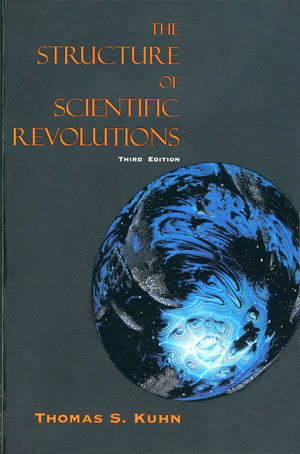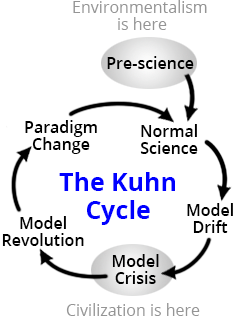The Kuhn Cycle is a simple cycle of progress described by Thomas Kuhn in 1962 in his seminal work The Structure of Scientific Revolutions. In Structure Kuhn challenged the world's current conception of science, which was that it was a steady progression of the accumulation of new ideas.
Ne Diyoruz Ne Anlıyoruz - Paradigma
The Steps of the Kuhn Cycle
Understanding the Kuhn Cycle and incorporating it into your approach to helping to solve the sustainability problem is so critical there are glossary entries for the prestep of Pre-science and the five main steps:
0. Pre-science - The field has no workable paradigm to successfully guide its work.
1. Normal Science - The normal step, where the field has a scientifically based model of understanding (a paradigm) that works.
2. Model Drift - The model of understanding starts to drift, due to accumulation of anomalies, phenomenon the model cannot explain.
3. Model Crisis - The Model Drift becomes so excessive the model is broken. It can no longer serve as a reliable guide to problem solving. Attempts to patch the model up to make it work fail. The field is in anguish.
4. Model Revolution - This begins when serious candidates for a new model emerge. It's a revolution because the new model is so radically different from the old one.
5. Paradigm Change - A single new paradigm emerges and the field changes from the old to the new paradigm. When this step ends the new paradigm becomes the new Normal Science and the Kuhn Cycle is complete.
Defining "paradigm"
 Thomas Kuhn defined paradigms as "universally recognized scientific achievements that, for a time, provide model problems and solutions for a community of researchers," (page X of the 1996 edition). A paradigm describes:
Thomas Kuhn defined paradigms as "universally recognized scientific achievements that, for a time, provide model problems and solutions for a community of researchers," (page X of the 1996 edition). A paradigm describes:
What is to be observed and scrutinized.
The kind of questions that are supposed to be asked and probed for answers in relation to this subject.
How these questions are to be structured.
How the results of scientific investigations should be interpreted.
In short, a paradigm is a comprehensive model of understanding that provides a field's members with viewpoints and rules on how to look at the field's problems and how to solve them. "Paradigms gain their status because they are more successful than their competitors in solving a few problems that the group of practritioners has come to recognize as acute." (page 23)
Why understanding the Kuhn Cycle is important
The global environmental sustainability problem is so large, complex, novel, urgent, and its solution so difficult that solving the problem entails creation of a new paradigm. Just conceiving of the problem requires a fundamentally new way of thinking. Before The Limits to Growth defined the problem in 1972, there was little realization that human system growth could not be infinite. So called "progress" cannot go on forever. The environment cannot be tamed and subjugated, as mankind has done before to everything else that stood in the way of "progress."
 Environmentalism finds itself in the Pre-science step of the Kuhn Cycle. It lacks a valid paradigm for solving its central problem of sustainability. Yet the field's members are assuming they are in the Normal Sciencestep, where a field has a paradigm that works well enough for that field to be called a bona fide science. This is a grave error.
Environmentalism finds itself in the Pre-science step of the Kuhn Cycle. It lacks a valid paradigm for solving its central problem of sustainability. Yet the field's members are assuming they are in the Normal Sciencestep, where a field has a paradigm that works well enough for that field to be called a bona fide science. This is a grave error.
Civilization as a whole is in the Model Crisisstep. The model it uses to run itself, mostly free market democracy, a collection of national governments, and some central coordination like the UN and the World Bank, is no longer capable of solving the world's top problems. The model was good enough to navigate through the Industrial Revolution, two world wars, the Great Depression, the Cold War, and other problems. The model shows no sign of being able to solve the global sustainability problem. Because of this void modern environmentalism appeared to fill the gap, beginning with Silent Spring in 1962. But the gap is large and difficult. The new field has so far been unable to provide a new model, a new paradigm, capable of solving the sustainability problem.
The top problem to solve is thus not the sustainability problem itself, but finding the new paradigm needed to solve it. Environmentalism and civilization may not know it but they are both in search of a paradigm that works.
Sources:
*www.thwink.org
**www.youtube.com






















Hiç yorum yok:
Yorum Gönder